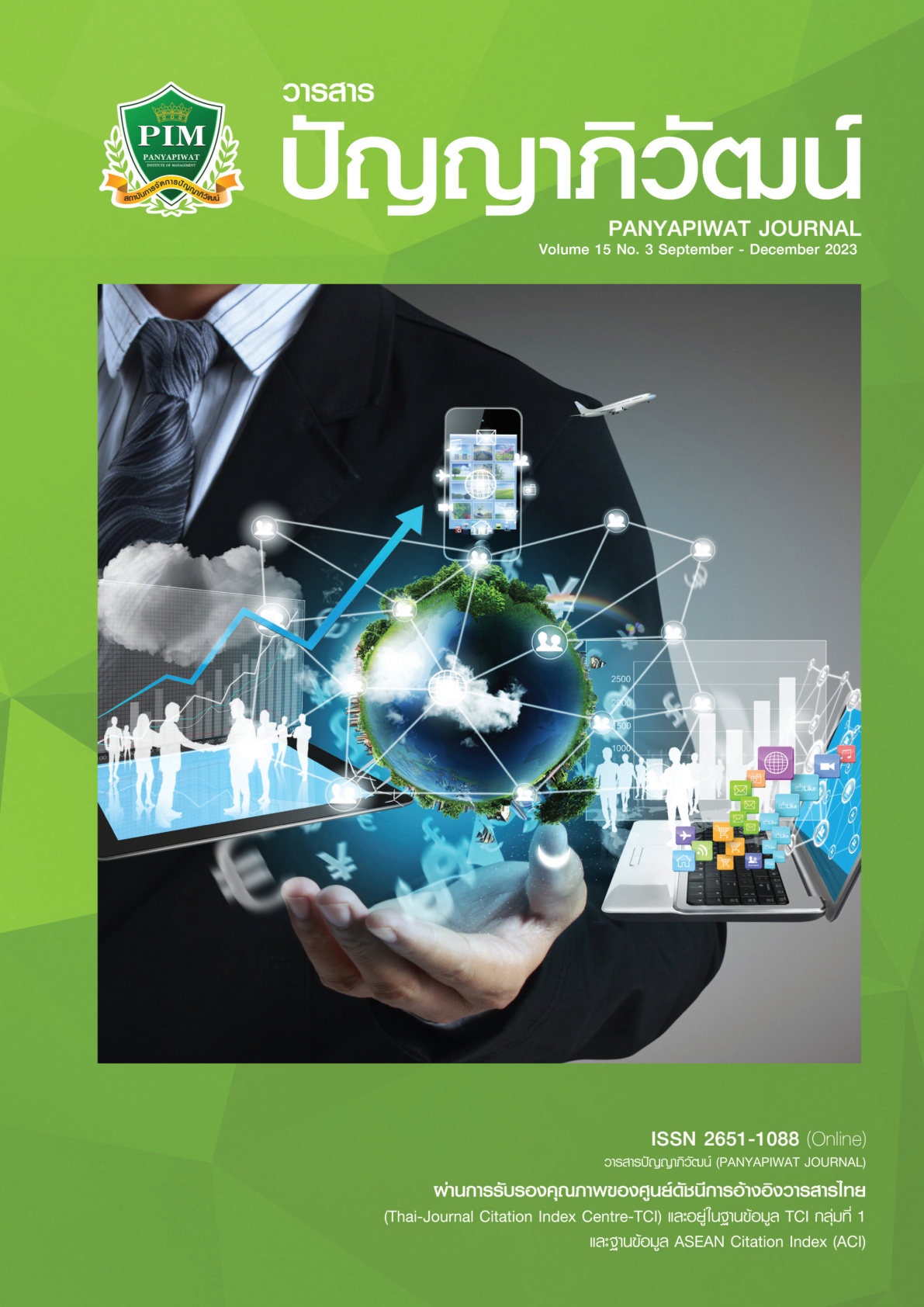การใช้บุคคลต้นเเบบเพื่อเสริมสร้างเเรงจูงใจในตนเอง
Main Article Content
บทคัดย่อ
บุคคลที่มีคุณลักษณะที่พึงประสงค์นอกจากต้องเป็นผู้ที่มีความรู้ความสามารถแล้ว ยังต้องมีคุณธรรม และจริยธรรมประกอบกัน จึงสามารถเป็นบุคคลที่มีคุณค่าในตนเองและต่อสังคม รวมทั้งเป็นต้นแบบหรือ แบบอย่างที่ดีให้แก่ผู้อื่นจนเกิดการยอมรับและปฏิบัติตามต่อไปได้ นอกจากนี้เป็นที่ยอมรับกันอย่างแพร่หลายว่า บุคคลต้นแบบถือเป็นแรงบันดาลใจที่สำคัญให้แก่ผู้อื่นในการพัฒนาตนเองผ่านการสร้างแรงจูงใจในตนเองจนมีพฤติกรรมและเกิดการกระทำที่มุ่งสู่เป้าหมายนั้น เพื่อให้ตนเองสามารถประสบความสำเร็จได้เช่นเดียวกันกับผู้ที่เป็นต้นแบบ ผู้เขียนได้เรียบเรียงบทความฉบับนี้โดยมีวัตถุประสงค์เพื่อนำเสนอแนวคิดเกี่ยวกับคุณลักษณะ ของบุคคลต้นแบบที่ดี อิทธิพลของบุคคลต้นแบบต่อการเลียนแบบพฤติกรรม ความสำคัญของแรงจูงใจ การสร้างแรงจูงใจในตนเอง รวมทั้งมุ่งชี้ให้เห็นความสัมพันธ์ระหว่างการใช้บุคคลต้นแบบกับการสร้างแรงจูงใจในตนเอง ซึ่งบทสรุปของบทความนี้ชี้ให้เห็นว่า บุคคลต้นแบบมีอิทธิพลเชิงบวกต่อพฤติกรรมของบุคคลและเป็นแรงผลักดันที่สำคัญแก่ผู้ปฏิบัติตามในการสร้างแรงจูงใจเพื่อพัฒนาตนเองให้บรรลุเป้าหมายที่วางไว้ผ่านการใช้หลักคิดและพฤติกรรมของบุคคลต้นแบบที่มีคุณลักษณะแตกต่างกัน อันจะนำไปสู่หลักการพิจารณาคัดเลือกผู้ที่ควรนำมาเป็นแบบอย่างที่ดี และการเลือกใช้แนวทางการดำเนินชีวิตตามบุคคลต้นแบบ เพื่อสามารถพัฒนาศักยภาพในแต่ละด้านของตนเองให้เต็มความสามารถ และมีคุณภาพชีวิตที่ดีงามอย่างยั่งยืนต่อไป
Article Details

อนุญาตภายใต้เงื่อนไข Creative Commons Attribution-NonCommercial-NoDerivatives 4.0 International License.
“ข้าพเจ้าและผู้เขียนร่วม (ถ้ามี) ขอรับรองว่า บทความที่เสนอมานี้ยังไม่เคยได้รับการตีพิมพ์และไม่ได้อยู่ระหว่างกระบวนการพิจารณาลงตีพิมพ์ในวารสารหรือแหล่งเผยแพร่อื่นใด ข้าพเจ้าและผู้เขียนร่วมยอมรับหลักเกณฑ์การพิจารณาต้นฉบับ ทั้งยินยอมให้กองบรรณาธิการมีสิทธิ์พิจารณาและตรวจแก้ต้นฉบับได้ตามที่เห็นสมควร พร้อมนี้ขอมอบลิขสิทธิ์บทความที่ได้รับการตีพิมพ์ให้แก่สถาบันการจัดการปัญญาภิวัฒน์หากมีการฟ้องร้องเรื่องการละเมิดลิขสิทธิ์เกี่ยวกับภาพ กราฟ ข้อความส่วนใดส่วนหนึ่งและ/หรือข้อคิดเห็นที่ปรากฏในบทความข้าพเจ้าและผู้เขียนร่วมยินยอมรับผิดชอบแต่เพียงฝ่ายเดียว”
เอกสารอ้างอิง
Anannawee, P. (2012). Principles, concepts theories for educational management (4th ed.). Montri.
Cruess, S. R., Cruess, R. L., & Steinert, Y. (2008). Role modelling--making the most of a powerful teaching strategy. BMJ Clinical Research.
Donahue, C. M. (2002). Athletes as role models. Current Health, 2(28), 22-24. Ezarik, M. (2000). A role model can change your life. Career World, (29), 18.
Gartzia, L., Morgenroth, T., Ryan, M. R., & Peters K. (2021). Testing the motivational effects of attainable role models: Field and experimental evidence. Journal of Theoretical Social Psychology, 5(4), 591-602. https://onlinelibrary.wiley.com/doi/epdf/10.1002/jts5.121
Gibson, D. E. (2003). Developing the professional self-concept: Role model construals in early, middle, and late career stages. Organization Science, 5(14), 591-610.
Haveman, R., & Wolfe, B. (1995). The determinants of children’s attain-ments: A review of methods and findings. Journal of economic literature, 4(33), 1829-1878.
Hrnote. (2019). What is the most important thing to motivate employees? https://th.hrnote.asia/orgdevelopment/whyimportantmotivation/
Humansoft. (2022). Ideas for motivating personnel in the workplaces. https://www.humansoft.co.th/th/blog/how-to-motivate-your-employees
Hurd, N. M., Wittrup, A., & Zimmerman, M. A. (2018). Role models. In R. J. Levesque (Ed.), Encyclopedia of adolescents (pp. 3179-3186). Springer.
Jopp, D. S., Jung, S., Damarin, A. K., Mirpuri, S., & Spini, D. (2017). Who is your successful aging role model? The Journals of Gerontology: Social Sciences, 72(2), 237-247. https://doi.org/10.1093/geronb/gbw138
Kearney, M. S., & Levine, P. B. (2020). Role models, mentors, and media influences, the future of children authors conference. https://files.eric.ed.gov/fulltext/EJ1262726.pdf
Kornpuang, A. (2019). Increasing the inspiration of undergraduate students with the zero projects from passions to mission project. In Inspiring student learning for diverse societies. The Proceeding of the 14th Conference (pp. 37-49). Office of The Higher Education Commission and Professional and Organizational Development Network of Thailand Higher Education. [in Thai]
Laulertrattana, C. (2010). Factors affecting motivation of the sports authority of Thailand. http://www.mpa-mba.ru.ac.th/images/Project/bangkok016/6317952023.pdf
Locke, E. A. (1976). The Nature and causes of job satisfaction. https://www.researchgate.net/publication/238742406_The_Nature_and_Causes_of_Job_Satisfaction
Lockwood, P., Marshall, C., & Sadler, P. (2005). Promoting success or preventing failure: Cultural differences in motivation by positive and negative role models. Personality and Social Psychology Bulletin, 3(31), 379-392.
Merton, R. K. (1957). Social theory and social structure. Free Press.
MGR Online. (2021). Discovery CSR & SD. https://mgronline.com/greeninnovation/detail/9640000003430
Minh Trung, T. (2018). The motivation for self development of Vietnamese students in Mahachulalongkornrajavidyalaya University [Master’s thesis]. Mahachulalongkorn -rajavidyalaya University.
Mookma, A. (2021). Learning Management by using role models to inspire and promote reading habits of first year undergraduate students, Chandrakasem Rajabhat University [Master’s thesis]. Sripatum University. [in Thai]
Morgenroth, T., Ryan, M. K., & Peters, K. (2015). The motivational theory of role modeling: How role models influence role aspirants’ goals. Review of General Psychology, 19(4), 465-483. https://doi.org/10.1037/gpr0000059
Office of the Royal Society Coined Word. (2019). Role model. https://coined-word.orst.go.th/ [in Thai]
Pawabunsiriwong, K. (2019). An analysis of role models in Thai EFL undergraduate students’ writing. Humanities and Social Sciences, 36, 232-256.
Pham Thi, V. (2010). Motivational orientation and participation in continuing education among staff nurses in general hospitals, the socialist republic of Vietnam. https://tdc.thailis.or.th/tdc/search_result.php
Promkhet, S. (2015). Self development motivation in conducting research among lecturers of Rajamangala University of Technology Srivijaya. Rajamangala University of Technology Srivijaya Journal, 7(2), 68-80. http://rdi.rmutsv.ac.th/rmutsvrj/download/year7-issue2-2558/p_68.pdf
Raso, S. (2012). Job performance motivation of personnel at Nakhon Sawan Rajabhat University. https://ir.swu.ac.th/jspui/bitstream/123456789/3756/2/Chotika_R.pdf
Rueangsuttha, P. (2021). A study of relationship between motivation and knowledge sharing behavior of employees in a state enterprise. https://archive.cm.mahidol.ac.th/bitstream/123456789/4582/1/TP%20HOM.025%202564.pdf
Sawaain, R., Wilairat, W., Maruekhi, S., Rukwong, M., & Buaparot, W. (2019). Building Inspiration from the master teacher for self-development of student teachers in the three Southern Border Provinces. Yala Rajabhat University. [in Thai]
Sornsithong, K. (2017). Work motivation among personnel working for the department of medical services [Master’s thesis]. Burapha University. [in Thai]
Sukhothai Thammathirat Open University. (2023). Motivation for learning. https://news.stou.ac.th/2023/01/06/tham/
Suwannasri, P. (2017). A study of the goal oriented approach of management by school administrators and the effect on motivation of teachers’ performance at Catholic Schools in Chanthaburi Diocese, Thailand. https://etheses.rbru.ac.th/pdf-uploads/allfile-270-file01-2019-02-21-08-16-22.pdf
Thirdthanakarn, T. (2003). Role model influences on imitation and purchase intent of high and low involvement products among adolescence [Master’s thesis]. Chulalongkorn University. [in Thai]
Verhoeven, M., Poorthuis, A. M. G., & Volman, M. (2019). The role of school in adolescents’ identity development. A literature review, Educational Psychology Review, 31, 35-63. https://doi.org/10.1007/s10648-018-9457-3
Walker, C. (2021). How to get things done when you don’t want to do anything. https://www.nytimes.com/2021/07/28/well/live/motivation-energy-advice.html
Yaowaboot, H. (2012). A study of the relationship between the motivation on self development and the self-esteem of nurses [Master’s thesis]. Srinakharinwirot University. http://thesis.swu.ac.th/swuthesis/Gui_Cou_Psy/Hathaikan_Y.pdf


